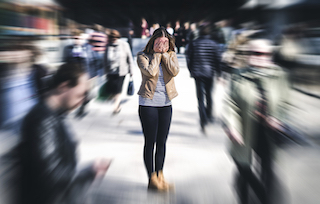 A new study published in the BMJ is providing clinicians with an up-to-date overview of available evidence from randomized clinical trials on the merits of non-surgical brain stimulation treatments for adults with major depressive episodes. Relapse rates of up to 80 per cent occur within one year of remission for depression. Drugs are effective for less than 50 per cent of people suffering from depression.
A new study published in the BMJ is providing clinicians with an up-to-date overview of available evidence from randomized clinical trials on the merits of non-surgical brain stimulation treatments for adults with major depressive episodes. Relapse rates of up to 80 per cent occur within one year of remission for depression. Drugs are effective for less than 50 per cent of people suffering from depression.
“Depression is a common and debilitating illness,” study author Julian Mutz told us. “Treatments including psychotherapy and drugs are effective but do not work for every patient and some patients experience undesired side effects. As such, there is a need to further develop new treatments, especially for patients who do not respond to drugs.”
The study, titled, Comparative efficacy and acceptability of non-surgical brain stimulation for the acute treatment of major depressive episodes in adults: systematic review and network meta-analysis, was authored by Mutz who is a doctoral researcher, along with Vijeinika Vipulananthan, psychological wellbeing practitioner, Ben Carter, senior lecturer in biostatistics, René Hurlemann, professor of medical psychology, and deputy head of department of psychiatry, Cynthia H Y Fu, professor of affective neuroscience, and Allan H Young, professor of mood disorders.
“Our study is about non-surgical brain stimulation treatments for severe depression,” Mutz told us. “Brain stimulation treatments such as electroconvulsive therapy (ECT) and repetitive transcranial magnetic stimulation (rTMS) use electrical currents or magnetic fields to change brain activity. The main objective of our study was to examine the clinical efficacy and acceptability of these techniques for the acute treatment of major depressive episodes in adults.”
Italy is where ECT was first developed in 1938. ECT works by inducing seizures in a patient through electricity. It used to be called electroshock therapy and was first used in the U.K. in 1939. Though it was showing positive results, the treatment began to get a bad rap when the U.S. surgeon general deemed ECT problematic because of the lack of anesthesia used for patients undergoing the treatment. It was also portrayed as an instrument of terror in the novel, One Flew Over The Cuckoo’s Nest by Ken Kesey. Use of ECT declined in the 1950s and 1970s as antidepressants came on the market but it has made a comeback in the last decade as technology has improved.
rTMS stimulates areas of the brain involved in controlling emotions by placing a magnetic coil against the scalp that sends magnetic pulses to the brain. The pulses change the activity of neurons and return the brain to normal functioning.
Mutz says previous research has shown that several of the treatments included in their analyses are effective in treating severe depression in patients who have not responded to drug treatment. However, previous studies were limited in scope of included treatments and they were hoping to gain more complete insights into the clinical efficacy and acceptability of these interventions.
“We did a systematic search of multiple electronic databases for clinical trials that examined the clinical efficacy and acceptability of brain stimulation treatments,” Mutz explained to us. “We then used a statistical method called network meta-analysis to summarize the results from these trials.”
Mutz and his colleagues examined data from 113 clinical trials with 6,750 patients randomly assigned to treatment. They found that bitemporal ECT, high-dose right unilateral ECT, high-frequency left rTMS and transcranial direct current stimulation (tDCS), were more effective than inactive (sham/placebo) therapy across all outcome measures in their network meta-analysis. For all active treatments, patients were no more likely to discontinue treatment than when they received inactive therapy.
“The main take-home messages are that non-surgical brain stimulation treatments should be considered as alternative or add-on treatments for severe depression in patients who have not responded to drug treatments,” Mutz told us. “Treatment protocols with robust evidence and more precision in treatment effect estimates (high-frequency left rTMS, low-frequency right rTMS, bilateral rTMS, and transcranial direct current stimulation) should be prioritized over novel protocols with a more limited evidence base. It is also evident from our review that there is a need to conduct further randomised controlled trials for novel treatment protocols (e.g. magnetic seizure therapy, theta burst stimulation).”
Mutz says they did not examine specific undesired side effects in the present work, and more systematic studies of side effects and adverse cognitive effects of these treatments are needed. A project aimed at specifically looking at side effects is currently underway (led by Maximilian Kiebs at University of Bonn Medical Centre and Mutz is also involved).
Patricia Tomasi is a mom, maternal mental health advocate, journalist, and speaker. She writes regularly for the Huffington Post Canada, focusing primarily on maternal mental health after suffering from severe postpartum anxiety twice. You can find her Huffington Post biography here. Patricia is also a Patient Expert Advisor for the North American-based, Maternal Mental Health Research Collective and is the founder of the online peer support group - Facebook Postpartum Depression & Anxiety Support Group - with over 1500 members worldwide. Blog: www.patriciatomasiblog.wordpress.com
Email: tomasi.patricia@gmail.com